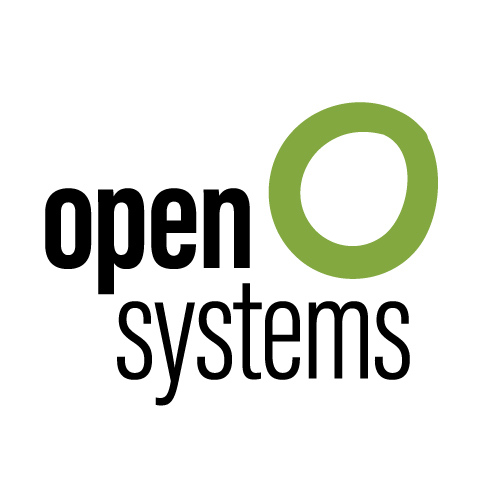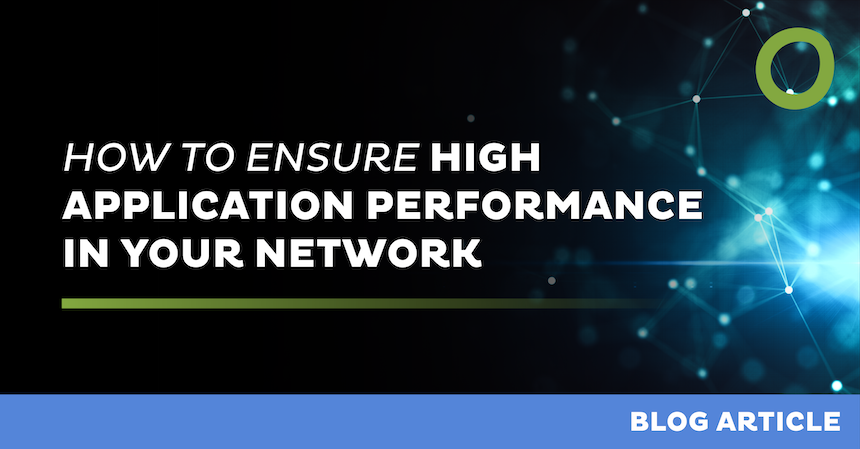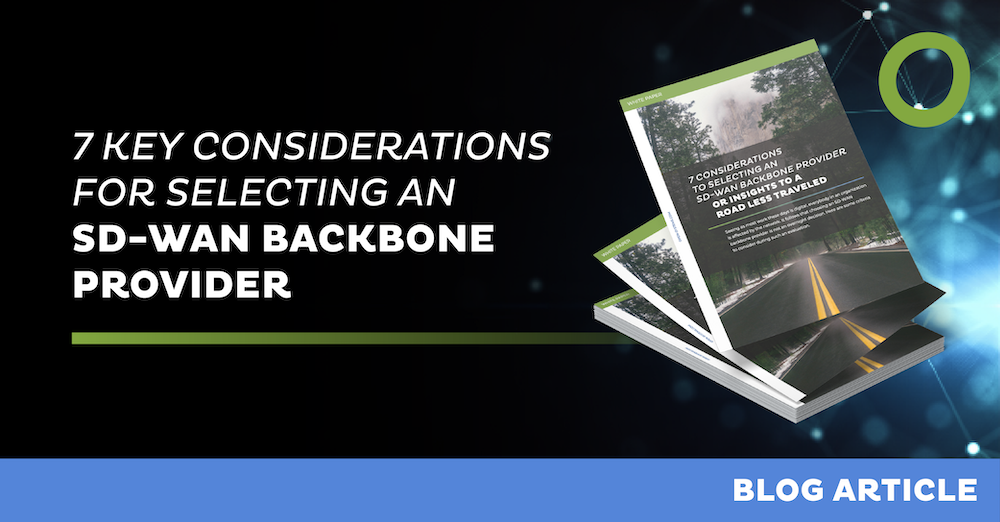
How to Ensure High Application Performance in Your Network


Why High Application Performance Is Important
For IT decision-makers, high application performance in their network means enhancing efficiency, reducing downtime, and supporting business continuity — especially critical for companies with multiple physical locations.
Read on for a refresh in Network Performance 101 and the key decisions to get the most out of your applications. Or check out our other blog on optimization in the SD-WAN stack.
Understanding Network Performance
Key Metrics for Network Performance
Latency and Bandwidth
Latency measures the time it takes for data to travel from the source to the destination. Bandwidth refers to the maximum rate at which data can be transferred over a network.
In other words, latency is the time it takes for a car (data) to travel from one end of the highway (source) to the other (destination). Even if the road is wide, it will still take a significant amount of time to reach the destination if it’s long (high latency).
Bandwidth determines how many cars can travel on the highway simultaneously. A highway with many lanes (high bandwidth) allows more cars (data) to travel at the same time, increasing the overall capacity of the highway.
Throughput, Packet Loss, and Jitter
Throughput is the actual rate of successful data transfer over a network. Packet loss occurs when data packets fail to reach their destination.
To use the same illustration above, consider throughput as the number of cars that successfully reach their destination within a certain time. Packet loss is like cars breaking down or getting lost along the way.
If many cars experience breakdowns or take wrong turns (packet loss) and never reach their destination, the number that successfully completes the journey (throughput) is reduced.
Jitter measures the variation of latency. If jitter is high, it means that data packets arrive at their destination with a high delay variation. In illustrative terms, jitter is the unpredictability of a route: a car that leaves later than another arrives earlier at the destination. Since data packets need to be arranged in a certain order to make sense of the data, it’s important that the variation of latency is kept low.
How to Assess Current Network and Application Performance
Factors Influencing Application Performance
Distance Between the User and Application
The physical distance between users and applications can significantly affect performance due to increased latency. Deploying applications closer to end-users — like with edge computing or a well-planned cloud architecture — can mitigate these delays.
Connectivity
It’s easier to handle large data volumes efficiently with more bandwidth. But the speed of your network connection affects how quickly data can be transmitted. Upgrading to faster connections — like fiber optics — can make a substantial operational difference.
Furthermore, the stability of network connections is crucial: high packet loss and jitter can lead to "data holes.” These holes are reflected in flickering real-time dashboards, delayed video streams, or poor processor performance.
Network Routing and Application Protocols
Efficient network routing ensures data takes the shortest and fastest path to its destination. Optimizing routing protocols — like Open Shortest Path First (OSPF), Border Gateway Protocol (BGP), and Equal-Cost Multi-Path (ECMP) — along with configurations can reduce latency and improve performance.
Especially in the case of hybrid deployments — on-premises and cloud, and in the context of SD-WAN — it’s important to have a well-designed routing architecture to ensure high user and application experience.
Click here for a deeper dive on application performance management.
Performance Testing
High application performance requires load testing, stress testing, and endurance testing. For example, a load test would simulate 1,000 concurrent users from the same location accessing an internally hosted app (like a sales quoting tool) to ensure the network and the app can handle the traffic during the end of a quarter.
A stress test would Increase the load to 10,000 concurrent users from the same location (on the same quoting tool) to identify any failure points — either on the underlying connectivity, the overlaying network infrastructure, or the application and security layer.
An endurance test would run the quoting tool with 1,000 concurrent users continuously for 48 hours to ensure the entire architecture can maintain performance.
Hardware and Infrastructure Optimization
Optimizing Network Connections
It’s crucial to choose a high-bandwidth, low-latency, and high-reliability connection for the most critical user-to-application paths. In addition, ensuring direct routes between users and applications – and prioritizing critical application traffic within a private, software-defined wide area network (SD-WAN) – will save companies from many other time-consuming and costly application performance measures.
Upgrading Network Hardware
In addition to better routers and switches, high-performance NICs are specialized hardware components that facilitate the efficient transfer of data between a computer and a network. They support technologies like Remote Direct Memory Access (RDMA) and TCP/IP offload, enabling faster data processing and lower CPU utilization.
Load Balancing
Load balancers distribute network traffic across multiple servers to prevent overload and ensure smooth operations.
Hardware load balancers offer high performance and can handle large volumes of traffic with low latency. However, initial costs are higher due to the expense of purchasing physical hardware, and configuration and updates may be less flexible.
Software load balancers offer flexible scalability by adding more instances or virtual machines. Maintenance costs include software support and updates, which can be automated.
Network Configuration Best Practices
IP Address Management
In addition to network segmentation for security, subnetting helps organize and manage IP addresses by breaking down a large network into smaller subnets – each with a range of IP addresses that match the size and needs of the sub-network. The subnet mask determines which part of the IP address represents the network and which part represents the host.
Relatedly, choosing between static and dynamic IP addresses depends on your network traffic and needs. A static IP is ideal for devices that need consistent network identification, such as servers, printers, and network equipment. A dynamic IP is more scalable for large networks, as IP addresses are allocated as needed without manual intervention.
Quality of Service (QoS) Settings
Configuring QoS means setting rules and policies that allocate network resources to prioritize traffic effectively; this enhances performance for essential applications. For example, you can use QoS settings to classify voice and video packets and place them in a high-priority queue. Or reserve a portion of the bandwidth for essential workloads to ensure high application performance in your network.
We’ve got more info here on network bandwidth control.
Security Measures
It’s important to determine if you need a network firewall, a web application firewall, or a next-generation firewall (NGFW): traditional firewall capabilities with advanced features like deep packet inspection and application awareness.
Likewise, network or intrusion detection systems monitor network traffic for suspicious activities, helping maintain network security and performance. Either way, the chosen solution should align with your organization's security policies and compliance requirements, such as NIS2, HIPAA, or GDPR.
Application Layer Optimization
Content Delivery Network (CDN) Integration
CDNs distribute content across multiple servers globally, reducing latency and improving load times for stronger application performance in your network.
Selecting a CDN provider includes numerous factors. To ensure your content is always accessible, look for high availability commitments — ideally 99.99% or above. Also, check if your provider offers automatic scaling capabilities to accommodate growing user demand without manual intervention.
Distributed Computing and Cloud Services
Look for providers offering specialized services such as big data analytics, IoT, and serverless computing. And assess performance benchmarks like latency, data transfer speeds, and processing power.
Software Optimization Techniques
Caching Strategies
Caching is storing a subset of data—typically transferred from one point to the other—so that future requests for the same data are served up faster. This saves time from having to access the data’s primary storage location or wait for the data transfer to happen. Caching allows you to reuse previously retrieved, computed, or transferred data efficiently.
In-memory caching directly stores data in the memory (RAM) of a single server or application instance. It allows for extremely fast read and write operations because data is accessed directly from memory rather than disk.
Distributed caching stores data across multiple servers or nodes in a cluster. It provides a unified cache that can be accessed and updated by multiple application instances across different machines.
Code Optimization
Using efficient algorithms to compress or assemble data can significantly reduce processing times and resource usage. For example, choosing the right data structures, optimizing time and space complexities, and avoiding unnecessary computations with caching can optimize data handling and output.
Continuous Monitoring and Maintenance
Automated Monitoring Solutions
Automated monitoring solutions provide real-time insights and alerts, enabling proactive management of network protocols. Select tools that offer comprehensive monitoring capabilities for hybrid environments, user-friendly interfaces, and integration with existing systems for seamless operations.
Regular Network Audits
Conducting regular network audits helps identify potential issues and areas for improvement. Audits should be thorough and cover all critical aspects of your network infrastructure. This means setting clear audit goals, considering external consultants, and developing a detailed checklist and timeline for the audit process.
Check out what makes network optimization so important.
Open Systems Can Help You Optimize Your Application Performance
Open Systems helps companies achieve stronger application performance through our expertise in network infrastructure and security optimization. We ensure your network operates efficiently with advanced tools and services like secure SD-WAN, advanced threat protection, and best-in-class managed and professional services.
Want to chat application performance? We’d love to hear from you.
Leave Complexity
Behind
To learn how Open Systems SASE Experience can benefit your organization, talk to a specialist today.
Contact Us



